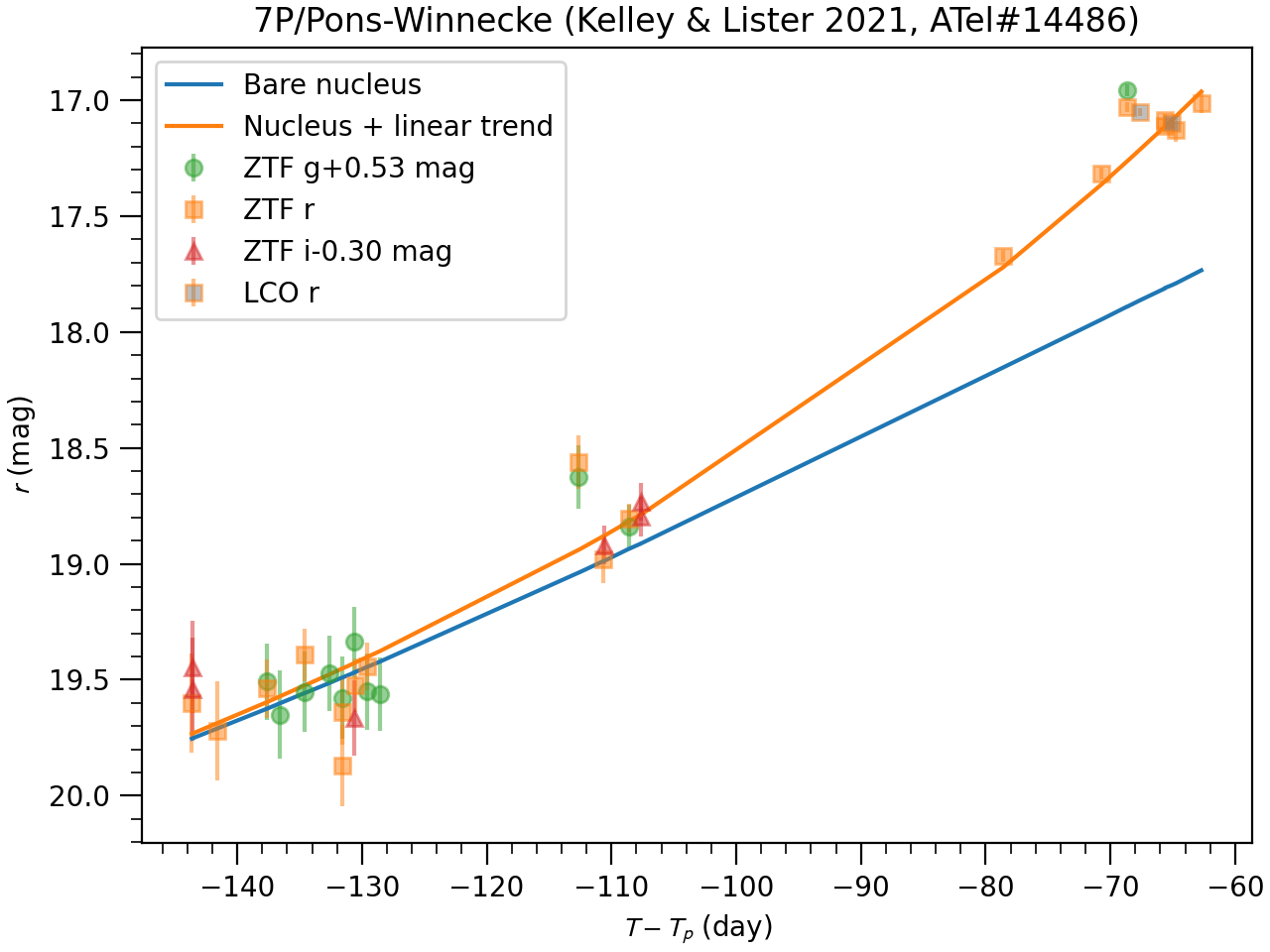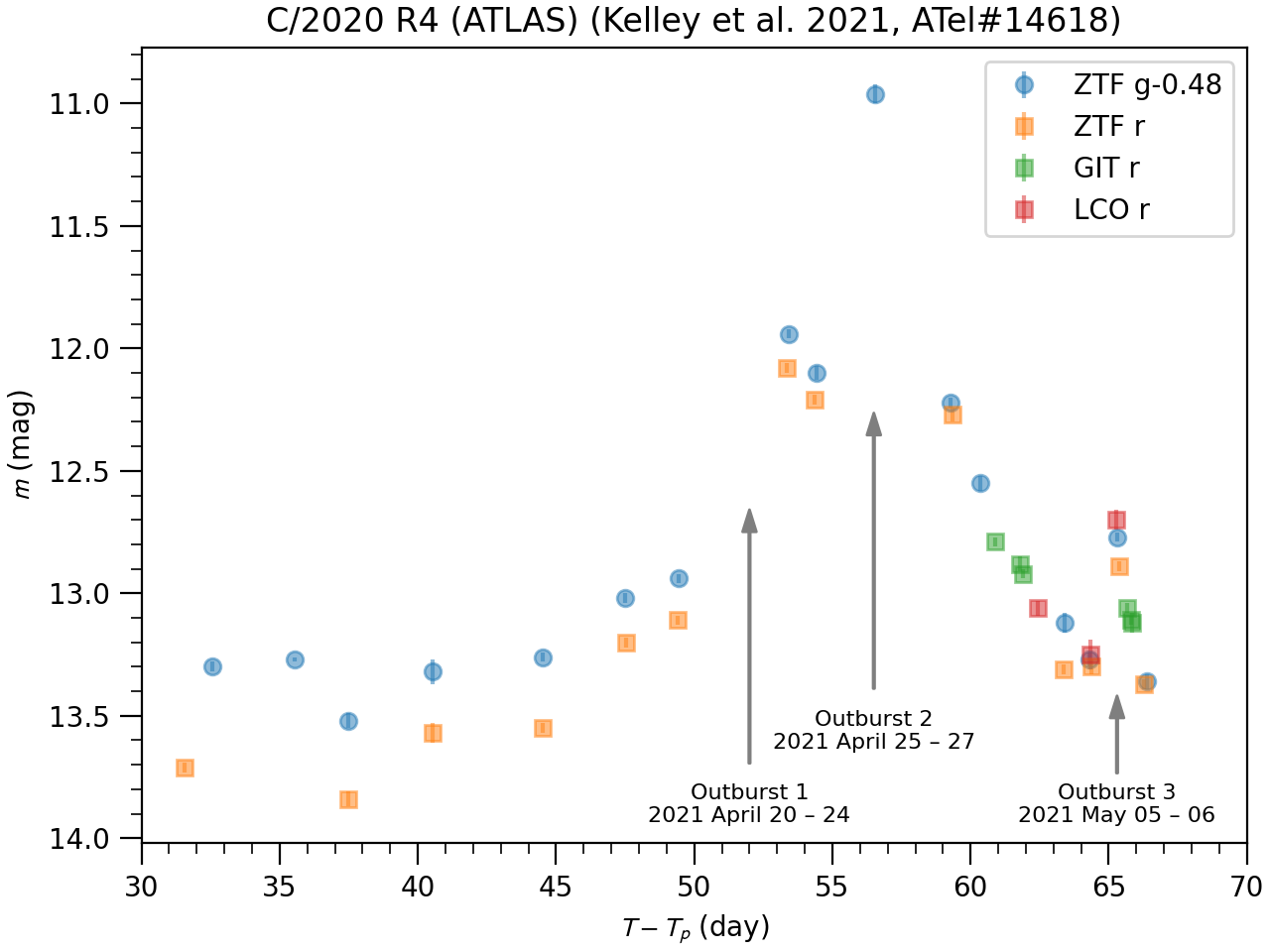LCO Outbursting Objects Key (LOOK) Project
June 30, 2021
We are interested in determining the frequency and nature of outbursts on small bodies across the Solar System. The LCO Outbursting Objects Key (LOOK) Project has two main objectives: 1) We will use the telescopes of the LCO Network to systematically monitor a sample of Dynamically New Comets (from the Oort cloud) over the whole sky. By studying this population's brightness and morphology changes as they pass through the inner Solar System, we can assess their evolutionary state (primitive vs. processed), identify targets for immediate or future follow-up (e.g., outburst vs. ambient coma composition), and, ultimately, better understand the behavior of these distant members as remnants of the early formation of the Solar System. It will also allow us to optimize the science return of the ESA Comet Interceptor mission and other future missions and gain a greater understanding of the interstellar objects that are just beginning to be discovered. 2) We will use the alerts and other data from the existing sky surveys such as ZTF, PanSTARRS1 & 2, Catalina and ATLAS to search for outburst activity in small bodies (comets, asteroids, centaurs) and rapidly respond to these outbursts with the telescopes of the LCO Network. This will enable us to better understand the nature of the outburst process, their frequency and magnitude distribution, and its evolution with time. Moreover, this will allow us to gain a better understanding of the physics of activity and outbursts on small bodies and the distribution of volatiles across the Solar System. This program exploits the synergy between current and future wide field surveys such as ZTF, PanSTARRS and LSST and rapid-response telescope networks such as LCO. Techniques, data reduction and analysis software developed during this Key Project and implemented on the ZTF survey and previous LCO programs will be an excellent “scale model” and testbed for what will be needed for the much larger number of objects coming from LSST. We've also teamed up with the Faulkes Telescope Project's Comet Chasers educational outreach program to provide a source of interesting targets for school children to follow up.
Gallery
 7P/Pons-Winnecke outbursts, March 2021
7P/Pons-Winnecke outbursts, March 2021![[object Object]](/~msk/static/lister22fig5-b63dc6c6b1333fe049e5704eca2678d6.jpg) 7P/Pons-Winnecke post-perihelion outbursts
7P/Pons-Winnecke post-perihelion outbursts![[object Object]](/~msk/static/lister22fig6-ac71c4b21413fd823f5aef71c1c51833.jpg) 57P/duToit-Neujmin-Delporte, October/November 2022
57P/duToit-Neujmin-Delporte, October/November 2022![[object Object]](/~msk/static/lister22fig8-12655cfefbced26b69a25c4c581cd928.jpg) 156P/Russell-LINEAR lightcurve
156P/Russell-LINEAR lightcurve![[object Object]](/~msk/static/lister22fig9-fc708a94043b6e3125a4e9e0c0bf1196.jpg) 156P/Russell-LINEAR morphology
156P/Russell-LINEAR morphology![[object Object]](/~msk/static/lister22fig7-b496a3d20464047dcbf506e068e3848b.jpg) P/2020 X1 (ATLAS) lightcurve
P/2020 X1 (ATLAS) lightcurve![[object Object]](/~msk/static/2014UN271_210621_rmean_v5-60887f1ca2b97a6cb6494de4a5495781.png) C/2014 UN271 is a comet, June 2021
C/2014 UN271 is a comet, June 2021![[object Object]](/~msk/static/kelley22-c2014un271-fig1-89421695649624f6d0bbc77c16651035.jpg) C/2014 UN271 morphology, June 2021 to February 2022
C/2014 UN271 morphology, June 2021 to February 2022![[object Object]](/~msk/static/kelley22-c2014un271-fig2-ccf73fd823447e4301a6e9e169ead703.jpg) C/2014 UN271 color, June 2021 to February 2022
C/2014 UN271 color, June 2021 to February 2022![[object Object]](/~msk/static/kelley22-c2014un271-fig3-4cb15a5e1bfd9f3ae617dad0f5dbcb66.jpg) C/2014 UN271 lightcurve, June 2021 to February 2022
C/2014 UN271 lightcurve, June 2021 to February 2022![[object Object]](/~msk/static/kelley22-c2014un271-fig6-edit-0e870b8dd277576b085dec612f8a223a.jpg) C/2014 UN271 lightcurve, June 2021 to February 2022
C/2014 UN271 lightcurve, June 2021 to February 2022![[object Object]](/~msk/static/lister22fig4-acdbcc31893d790de16300c5c21174cb.jpg) C/2019 L3 (ATLAS) and C/2020 R7 (ATLAS)
C/2019 L3 (ATLAS) and C/2020 R7 (ATLAS) C/2020 R4 (ATLAS) outbursts, April/May 2021
C/2020 R4 (ATLAS) outbursts, April/May 2021![[object Object]](/~msk/static/lister22fig11-aadbe62f0124a459f3312be157bc72fb.jpg) C/2021 A1 (Leonard) morphology, November 2021
C/2021 A1 (Leonard) morphology, November 2021
Collaborators
We have a large team of cometary, outer solar system, and asteroidal experts, primarily derived from the LSST Solar System Science Collaboration's Active Objects Working Group and the Comet Interceptor Ground-based Observer Team.
Michele T. Bannister
University of Canterbury, NZ
James Bauer
University of Maryland
Dennis Bodewits
Auburn University
Joseph Chatelain
Las Cumbres Observatory
Matthew Dobson
Queen's University Belfast
Estela Fernández-Valenzuela
University of Central Florida
Daniel Gardener
University of Edinburgh
Geza Gyuk
Adler Planetarium
Mark Hammergren
Farther Horizons LLC
Carrie Holt
University of Maryland
Henry Hsieh
Planetary Science Institute
Man-To Hui
University of Hawaii/Macau University of Science and Technology
Emmanuel Jehin
University of Liège
Michael S. P. Kelley
University of Maryland
Matthew Knight
US Naval Academy
Rosita Kokotanekova
European Southern Observatory
Eva Lilly
Planetary Science Institute
Tim Lister
Las Cumbres Observatory
Adam McKay
Appalachian State University
Youssef Moulane
Auburn University
Cyrielle Opitom
University of Edinburgh
Silvia Protopapa
Southwest Research Institute
Ryan Ridden-Harper
University of Canterbury, NZ
Charles Schambeau
University of Central Florida
Megan Schwamb
Queen's University Belfast
Colin Snodgrass
University of Edinburgh
Cai Stoddard-Jones
Cardiff University
Helen Usher
The Open University, UK
Kacper Wierzchos
Catalina Sky Survey, University of Arizona
Padma A. Yanamandra-Fisher
Space Science Institute
Quanzhi Ye
University of Maryland
Observations
We use the NEOexchange Target Observation Manager (Lister et al. 2021) to schedule observations. NEOx provides a solar system centered interface to the Las Cumbres Observatory scheduling system. Below is a summary of our observations taken up to 2022-03-06.
0 rows
| Object | First date (UTC) | Last date (UTC) | Δt (days) | N epochs | First rh (au) | Last rh (au) | Total exposure time (s) |
|---|
0 rows
Δt = total time span covered, N epochs = approximate number of distinct observational epochs, rh = heliocentric distance (<0 for pre-perihelion epochs).
Publications
0 rows
| Target | Date | Description | Reference |
|---|
0 rows